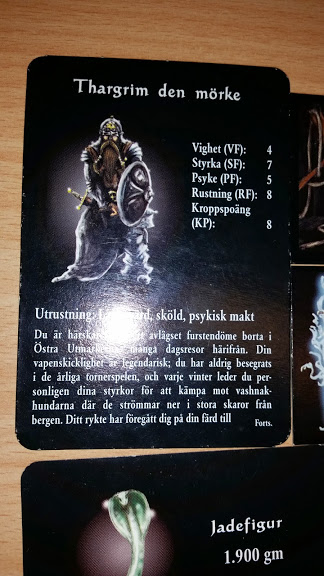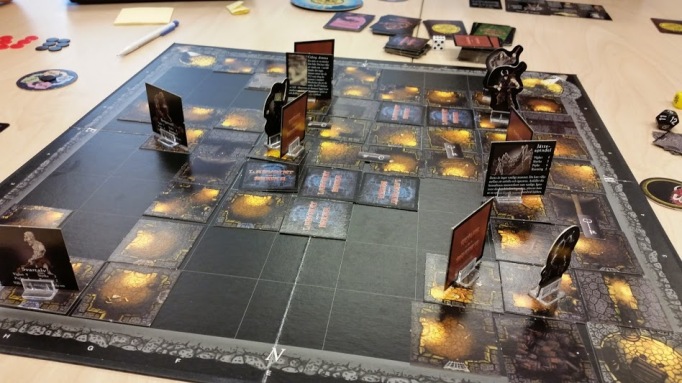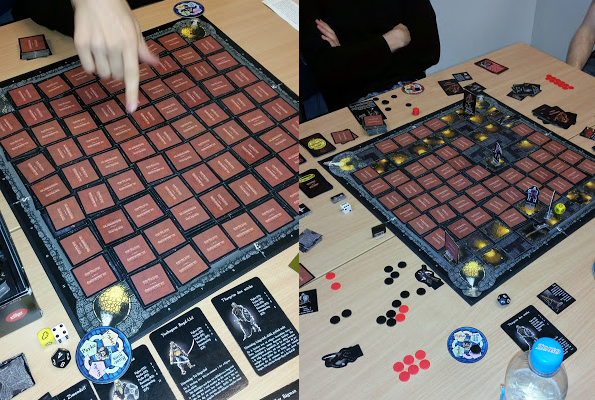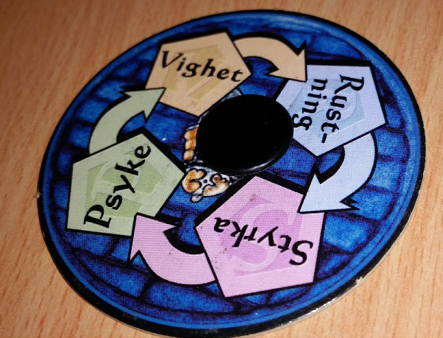Right, so this time I’m actually going to perform an analysis of the board game Drakborgen Legenden.
Basically this is a board game where you choose a character at the start of the game and venture into a castle that a dragon calls home, hoping to loot the most treasure, fight monsters and make it out in one piece before the sun sets.
The character that you choose have five main stats, Strength, Agility, Armor, Mentality (I suppose it would translate to) and Health. The value of each stat depends on the character chosen, allowing for “classes” like knights with high armor and ninjas with high agility.
These stats are mainly used for two things. The first is to overcome obstacles that present themselves along the way, such as navigating rubble-filled rooms or forcing doors open. The second is for combat, that will be described further below.
Additionally some of the characters (but not all), have additional abilities. The mage for instance starts the game with a selection of spells and another character has the ability to move twice as far through already discovered Labyrinth Tiles. These abilities can be very valuable, but tend to give the character lower values in the main stats to compensate. These penalties can however on occasion be overcome, as the player, if lucky, can find equipment to boost stats.
The game consists of a number of systems, some better and some worse. Following here is a description of these systems, and an evaluation of the better and worse among them.
Movement System (Exploration System)
The core system, and also the best system, within the game is the Movement System.
I would have liked to call this system the Exploration System however, since there is more within it than just moving your character from one tile to another. Even tough that is largely the effect you seek in the long run.
For instance you can substitute your movement for resting, hoping to recover lost Health, use specific character abilities or open doors.
On the games board there is a grid pattern representing room’s positions. As the game starts this grid is filled with tiles called Labyrinth Tiles, placed face down. On top of these are placed a second layer of tiles called Room Tiles.
The Labyrinth Tiles represent rooms or corridors with at least one available passageway, one of which will be marked as its entrance. These are the tiles that will show the layout of the castle and are what that the character will move between. The Room Tiles then represent what is within the room, such as monsters or treasure.
A character’s movement usually simply consist of him/her declaring that his/her character should move from its current position to an adjacent tile through open passageways. As the character moves onto undiscovered tiles they are flipped, shown and placed with the entrance marker towards the passage that the character entered from. The ultimate layout of the castle thus depends on the movement and direction of the player’s characters. This random element is also a large part of the games replay value.
As undiscovered tiles are flipped, if the room displayed permits it, its Room Tile is activated. Most rooms do, however corridors or rooms filled with debris, for example, doesn’t. Additionally, corridors allow the character to immediately move to another subsequent tile.
If a character however moves into a room that has already been discovered, no Room Tile is activated, and the movement is generally safe and done.
Another part of the Movement System is overcoming obstructions. If for instance a door, metal bars or a room filled with rubble obstructs the players path he/she may as part of the movement attempt to overcome and move past these.
For this the characters main stats are consulted and a die (d12) is rolled for the appropriate stat to see if the character manages to overcome the obstacle. If successful the character may immediately move past the obstacle into a subsequent tile, and if not the character isn’t allowed to move from the current tile.
The Movement System does have relationships with other systems, as the character’s position is relevant for the Time System, the Dragon Loot System and the Combat System.
This is however mainly to see if the character occupies the relevant tile to take, or be forced to take, certain actions. Or as in the Time System if the character dies or not (see below).
Overall the Movement system managed to give a functioning feeling of exploration as the castle is randomly generated and is revealed as you progress.
As a side note to the exploration system, or rather how the game was supposed to be set up, the ENTIRE board was supposed to be filled with tiles, face down, from the start. In two layers. This made it very bothersome to turn them over as you progressed. Why would you make it an actual part of the rules to set the board up like this? We all agreed it would be a lot cleaner and more convenient to have the Labyrinth Tiles and Room Tiles in separate decks next to the playing board, and then you’d simply grab a Labyrinth Tile when progressing and IF the room requires a Room Tile you can grab one from the appropriate deck.
The effect on the rules during gameplay would be minimal (save for one Magic Map, but this could easily be fixed by putting Labyrinth Tiles down on relevant positions as it was used) and give the player a cleaner experience. Also more exciting, I would like to claim, since the tile would be drawn by the player and not lain down in advance, thus interpreted more as being dependent on the player’s own actions.
Health System
The worst system in the game was probably the Health System. It was not perhaps very complicated rule-wise, but quite unintuitive. I believe we got it right first while playing on the third session.
The Health System consists of in part the character’s Health Points, and in part by what were called “Damage Points”.
The players Health Points are his permanent health. If points are lost they remain lost for the remainder of the game, and if the Health Points are depleted, the character dies and the player loses the game. So far so good.
Then, however, the player has Damage Points. This is temporary damage that the character can sustain during combat without taking permanent damage, since they regenerate after battle to equal the remaining Health Points. Should the Damage Points however be depleted the character dies and the player loses the game.
Outside combat any damage sustained is usually directed towards the characters Health Points. Any loss of Health Points at any time would directly result in an equal loss of Damage Points. Still with me?
During combat however the player can decide if he accepts damage done as loss of Damage Points, or risk to “Chance Damage” for each individual Damage Point that would have been lost. By choosing to Chance Damage the player rolls a special die to see if the damage is negated, or if he instead receives damage directly to his Health Points (and thus his Damage Points as well).
Yup. This is simply… no. Having two states of Death, one when your actual Health depletes, and one when what appears to be a “shield” depletes, as well as a very haphazard system for negating damage is simply too much for something as simple as Health. And as stated above, this system was so unintuitive that it took us hours of gameplay to get it right, and even then we weren’t really sure if it was ever good to Chance Damage unless certain death was looming over you.
Room System
This was another main system in the game. It however functioned, as far as I could tell, mostly as a gateway to other systems.
As you enter a previously undiscovered Labyrinth Tile you generally have to reveal a Room Tile as well, and follow the instructions displayed on this tile.
The instructions can vary from spawning a monster (that leads to the combat system), a curse that rotates all corridors (thus affecting the movement system), to finding treasure (that I suppose would function as another property for the players character, only having relevant behaviors when for instance the player risks loosing them or to compare their value at the end of the game.).
Although as a system this may be the primary one, since it can lead to or affect pretty much every other system in the game, I sill decided on the Movement System as being the main one. This because I determined the core gameplay to be the exploration of the dungeon, rather than the effects of the rooms the characters enter.
Combat System
As a monster is encountered the player gets the option to Attack, Await or to Flee. Depending on the action chosen, the Monster Player (tasked with playing as the monster during the combat phase. By the rules this is the player sitting to the active player’s right.) consults a Monster Card to see the monsters reaction and Health Points if a battle is going to take place.
Some characters have special abilities that can be used prior to combat, such as that the archer can fire arrows or the ninja can attempt to hide instead of fighting.
Then once the actual battle takes place, the Combat System mainly utilizes a kind of transitivity cycle using the four main stats (that is excluding health) as attributes. These attributes are displayed on a Combat Disk, clearly showing in what order they defeat each other.
A standard combat round is that both the Player and the Monster Player decides on an attribute that their character would like to use in the combat round. The very first round they are allowed to select any attribute that they please, and subsequent rounds they may keep the same attribute or move the marker one slot either left or right. These are then displayed, and if one trumps the other 1 Damage Point worth of damage is dealt to the loosing character.
This transitivity system however does have a couple of special rules. First if both players have selected attributes on opposite ends this counts as a miss. Three misses in a row will cause monsters to flee, if they are currently occupying a Labyrinth Tile that has clear passageways. Thus the Combat System and Movement System interacts to see if escape is possible.
The second special rule is that if both players have chosen the same attribute, their characters correlating stats are compared, and the one with the lower number looses the difference in Damage Points.
This was another system that I found rater lacking.
The system itself makes sense, but the manner in which it was implemented appears to have been with little thought.
Since generally low amounts of damage is caused (mainly by trumping), the chance of both characters missing and the implementation of the already mentioned Health System, this meant that combats could last a very long time. Sometimes without anything really happening, especially if there is no route for the monster to escape.
Treasure Loot System
This was also one of the systems that functioned very well. Much thanks to its simplicity.
While a player’s character is positioned in the dragons treasury he/she may each turn, instead of moving, draw Treasure Cards, receiving anything from a few coins to jewels or regalia.
Each turn a player spends doing so however that player must also draw a Dragon Card, to see if the dragon occupying the treasury will remain asleep, or if it will wake up and cause the players a lot of heartache, since this usually means that the players currently in the treasury have to drop the majority of their hard earned treasures and flee. More than one player can collect treasures at the same time, and since there are only 12 Dragon Cards the risk of remaining can increase quite quickly. Once the dragons treasury has been empty of players the Dragon Cards are collected and reshuffled, however if the dragon awakes it remains awake for the remainder of the game.
Time System
A system that, during our sessions, didn’t play an all too great role was the time system.
This was represented as a sundial on which were numbered 1-24 and an arrow to keep track of the current time.
After each complete round, that is after each player its turn, a special “sun die” is rolled. Depending on the outcome, the dials number increase or remain the same.
This system directly affects little within the game. It’s only function is to give the players a time limit as to how long they can remain within the castle, as all who are still inside when the dial reaches 24 will immediately count as dead and loose the game.
The problem that was all too obvious during the sessions we played was that it was entirely based on the die rolls. As chance would have it, nearly ever single time we rolled the outcome was that nothing happened. This negated any intended pressure and excitement from calculating risk and reward in moving forward.
If chance would have it the other way around though the round could have become significantly different, not allowing for casual exploration.
The bottom line is though that it is a system that doesn’t give a coherent experience and challenge from one session to another.
Target Audience: 10+
I would argue that the game should probably be aimed at an audience a few years higher.
The rules are perhaps a bit complex for many 10 year olds. Not that they couldn’t handle it, but I would imagine a lot of them wouldn’t really bother with it since it takes quite a bit of time to set up, understand the rules and to play.
The setting is also a bit designed for slightly older audiences. Combined with the artstyleand game systems, probably even teenage boys who are already interested in traditional pen and paper role playing games and are looking for something a little bit lighter for nights with friends.
I suppose 10+ is suggested since that is when you start to appreciate mechanics more in games, and I do agree that a 10 year old could probably play this game.
But in the end It is both a little bit too complicated and boring looking to appeal to a wide circle of players. I would even go as far as to call most of the art assets boring and slightly lazy. It really isn’t too hard to make a bit of variation on the room-tiles, they seriously all look pretty much identical..
As a final note, I have actually played the original Drakborgen that came out in the 80s, and that was a fantastic game. I was hoping this would be a great game as well, but somehow they had managed to make every single aspect of the game a little (or in some cases more than a little) bit worse. For shame I say, for shame…





Here is my review for your analysis
We could find some opinions throughout the text regarding some opinions, so i will try to see if i can get the best and worst sides of your analysis as i go. So first of addressing the rule of placing the tiles on the entire board, I totally agree that this is something really unnecessary and absurd. Trying to flip a tile placed out pushes the others out and you always have to align them again, a troublesome treat especially for the ones who don’t like messy games (and on top of that adding a second layer). The solution with not placing the tiles on the boards was a good one and also the same as we did. This way would keep it less messy and the game can proceed fluently without adding headache.
Regarding the health system, I would not say I would agree on that it’s too much to have two states of death, as I see it you have two “states of a character”, the board game character and the combat character. As I observed the first round our team played I was thinking about the combat system, I didn’t understand it at first so I had to ask about it, and it came natural to me when I asked if there were two different health modes. Let’s say that you have a set HP (Health points) of five points, moving around the board with two HP after the casualties of a previous combat would put you at risk of getting killed on the next tile you step on (if it is a combat tile etc), this would make the player feel like he has been cheated by the game. Thus it would make it better to add DP (damage points) for combats due to the effect of bringing anger of knowing how much damage a monster can inflict on you, and also the fact that you will be left with the health state and at the same time your enemy will always start fresh. Not having it would just lose the game balance. And the effect of “Chance Damage” is like a second chance, if you are one your last DP you can make use of this chance, if you are going down why not take the chance? This adds a lot of drama to the combat system and I deem it necessary as the combats needs a bit of color and life.
I am with you at the combat system, I think that this section of the game should have been more simplified as other players had to wait for it to be over, this could take out too much time of the gameplay itself thus resulting in the lack of motivation to continue to play. Being that the game uses rolling of dices this can rely mostly on chance, and if you are unlucky… the chances are not that good and can mess up the gameplay.
The first time we opened the box and got to see the character designs, or the “art style” I was a bit chocked, they were awful, I looked at the production year for this game and saw that this board game was from 1985 so I was like, okay if it was done now this art would not be accepted, it looked like children drawings. But then I read about it and the “Dragborgen Legenden” was remastered and published again with a few adjustments… and the one we had was from 2002…… if they had redone some stuff, they could have done the illustrations better. If some would say that the art style should not be changed as it would change the game appearance I would say that they have done a new board game with new features… why not make everything new?
Core systems
I think that you have identified the core mechanics pretty good here and you have described the game pretty thoroughly. And I agree with most of what’s written about them.
But I want to talk about the Time system as this is one of the core mechanics, the “sun dial” and the sun dice. I would like to say that this is the main thing with the game, the challenge is to get into the treasure chamber grab as much treasure as you can (and not waking the dragon up) and trying to escape before sundown is the real excitement of the game, rolling the dice here has the best function according to me. The game can end as quickly as a few round or continue until fifty rounds, this is what makes the game stressful and exciting at the same time. I don’t know how it worked in the first “Drakborgen” game but I’ve read that this is one of the new features added to the game.
I also want to add the resource system as a core. As you progress in the game you collect different treasures, some of them are worth coins etc, but also the resource as in the collection of different equipment like flaming swords or amulets, these gives you some extra in different attributes, if you have enough of luck to loot a strong enough gear you can actually slay the dragon and that gives you the chance to loot all the treasures (but still you will have to get out of there before sundown). And at the same time the gear helps you trough your battle system or even tiles. This one may be thought of the heart of the game as well, as it has a relation to all the other systems in the game.
The interesting systems
As I played Carcassonne before this board game, it turned out to be pretty similar (gathering points, placing tiles forming a land, etc). Even though it was more of a conquering roads or cities game, the most interesting gameplay was the placing of tiles, not knowing which tile would be next and try to take advantage of every chance you get, even if it was a tile that you couldn’t use. So the tile system that generates a random map every time you play negates the feel of a repetitive gameplay and at the same time give the excitement and stress every time one flip a tile to see what kind of map piece you need to play with.
The target audience
If we look at the side of the box we can see that the age set for this board game is 10+, but I would say that this game is too complicated for the majority of ten year olds. There is to much stuff going on, the rule and instructions are a few pages long, you will have to have someone to oversee the combats, and the different actions during gameplay. I would make this a few years higher, and aim for the target group 16+, according to me this is the most suitable age group, as I can’t see a gang of 10 year olds playing this together for hours and still enjoy it.
And that’s all for me! good job on cracking this one and having the patience to play it.
Best regards
Ahmad!
#5SD046 #5SD024